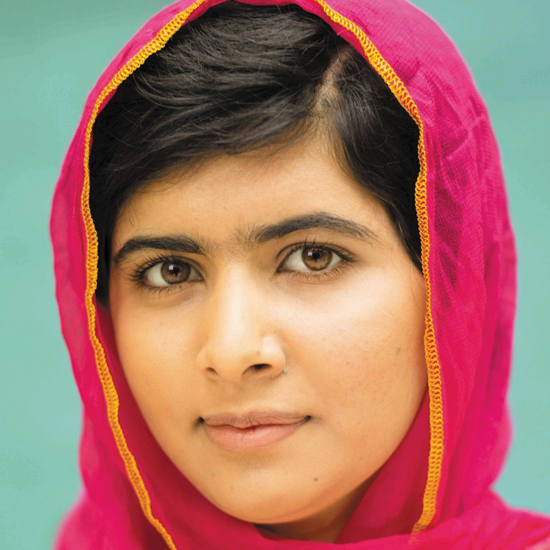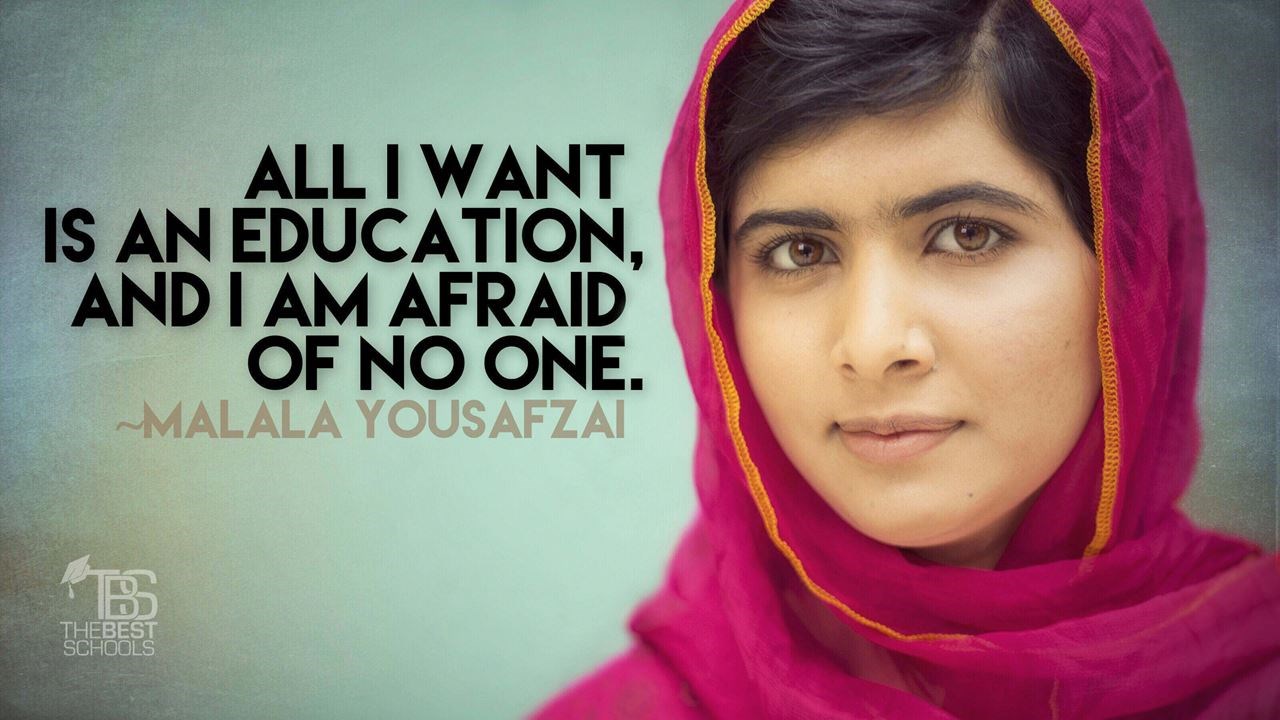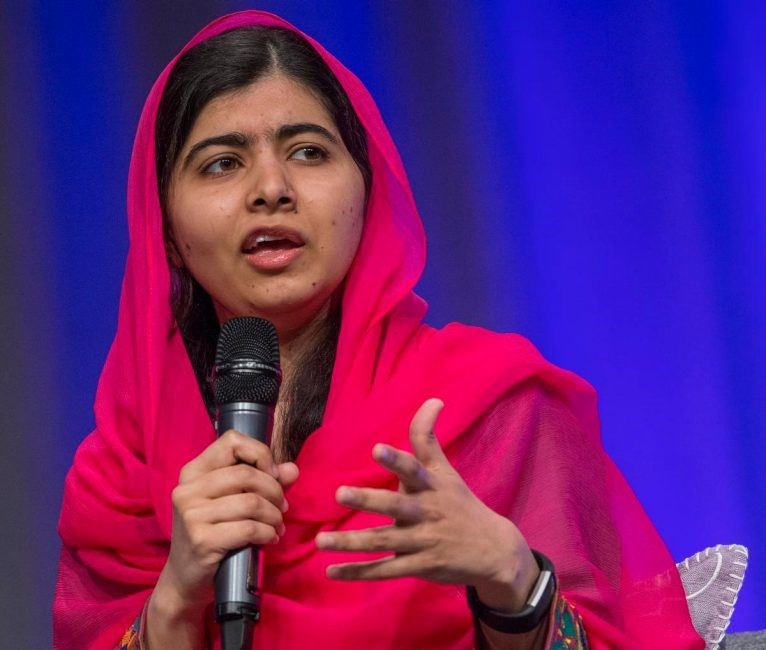 This shows an image of Malala Yousafzai, the girl who fought for her rightshttps://freedomcenter.org/voice/young-powerful-and-influential-how-malala-yousafzai-changing-worldOn October 9, 2012, a young girl named Malala Yousafzai was shot in the head by the Taliban, a religious group that was attempting to kill her for standing up for women’s rights. The Taliban threatened to kill Malala if she continued to go to school and speak out against them, but this did not discourage her from standing up for her rights and spreading her message. Malala grew up in Pakistan, where it was peaceful early in her life, but that changed when the Taliban seized control of the region where Malala lived. She began living in constant fear of being attacked by the Taliban when the extreme Islamic group threatened her and her family for not following strict Islamic traditions. Throughout the night, when Malala heard small sounds outside her house, she would tremble and worry the Taliban was going to break into her home and try to kill her and her family. Malala’s father was the owner and principal of the school she attended. He encouraged Malala to fight for her education and stand up for her beliefs. When the Taliban began to threaten her, her father encouraged her to continue as an educational activist and become a politician when she grew up. For years, Malala and her father were trying to spread the idea that women should have the fundamental right to get a quality education. Life for Malala changed one day when the Taliban shot her on her way home from school. It was when the Taliban shot her on her way home from school, the whole world heard about her fight against the Taliban, and she became a hero for standing up for what she believed in instead of backing down. A hero must possess bravery and determination. Someone like Malala was fighting for what she believed in, and nothing stopped her from continuing to fight for women’s rights even if it meant risking her own life. Malala Yousafzai took a bullet to her head, but that did not stop her from continuing to fight for equal rights for women in Pakistan. It was at the age of eleven when she began protesting that women should have the right to attend school and get a quality education like men. Malala is heroic because she is confident in her fight for equal education, brave because she speaks out against oppressive forces, and determined when she continued her passionate fight after her injury.
This shows an image of Malala Yousafzai, the girl who fought for her rightshttps://freedomcenter.org/voice/young-powerful-and-influential-how-malala-yousafzai-changing-worldOn October 9, 2012, a young girl named Malala Yousafzai was shot in the head by the Taliban, a religious group that was attempting to kill her for standing up for women’s rights. The Taliban threatened to kill Malala if she continued to go to school and speak out against them, but this did not discourage her from standing up for her rights and spreading her message. Malala grew up in Pakistan, where it was peaceful early in her life, but that changed when the Taliban seized control of the region where Malala lived. She began living in constant fear of being attacked by the Taliban when the extreme Islamic group threatened her and her family for not following strict Islamic traditions. Throughout the night, when Malala heard small sounds outside her house, she would tremble and worry the Taliban was going to break into her home and try to kill her and her family. Malala’s father was the owner and principal of the school she attended. He encouraged Malala to fight for her education and stand up for her beliefs. When the Taliban began to threaten her, her father encouraged her to continue as an educational activist and become a politician when she grew up. For years, Malala and her father were trying to spread the idea that women should have the fundamental right to get a quality education. Life for Malala changed one day when the Taliban shot her on her way home from school. It was when the Taliban shot her on her way home from school, the whole world heard about her fight against the Taliban, and she became a hero for standing up for what she believed in instead of backing down. A hero must possess bravery and determination. Someone like Malala was fighting for what she believed in, and nothing stopped her from continuing to fight for women’s rights even if it meant risking her own life. Malala Yousafzai took a bullet to her head, but that did not stop her from continuing to fight for equal rights for women in Pakistan. It was at the age of eleven when she began protesting that women should have the right to attend school and get a quality education like men. Malala is heroic because she is confident in her fight for equal education, brave because she speaks out against oppressive forces, and determined when she continued her passionate fight after her injury.
Malala Yousafzai’s confidence in her fight for equal education made her a hero in the eyes of people all over the world. At the age of eleven, Malala began to stand up for her educational rights and was confident that she could make a difference not only women in Pakistan but for all women all over the world. “Yousafzai continued to fight for the educational rights of girls, and she refused to stay silent on issues that mattered to her(Gale Student Resources in Context, “Malala Yousafzai”).” Malala wasn’t willing to give up the things that mattered to her so she stood up by giving speeches and tried to spread her message as far as she could. Malala knew that women should be getting the same quality education as men and she was confident that she was going to make a change in the world. “Yousafzai began speaking about education from an early age after her father brought her to speak at a press club. Her speech was covered by local news throughout the area. In 2009, Yousafzai became an educator at the Open Minds Pakistan youth program, part of the Institute for War and Peace Reporting(Schnee).” Malala was so confident she was going to make a change that she went on the news and gave speeches about her ideas and emphasized there needs to be a change in views of women’s education. She always believed in herself and never let anyone stop her from fighting for women’s equal education. Malala’s confidence enabled her to stand up and fight for women’s rights, despite the many threats she faced.
 Malala states that she is going to get her education, and no one is going to stop herhttps://www.buzymummy.com/2017/10/11/5-year-ago-shot-education-oxford-malala-yousafzai/Even though Malala faced many threats and challenges, her confidence enabled her to be brave and speak up against the oppressive forces. When the Taliban threatened to kill her for speaking out against them, she continued to fight for her rights and was brave even though she got death threats. “Yousafzai's father, who operated the school that his daughter attended, received death threats from the Taliban, and the family temporarily lived in a refugee camp. Despite these dangers, Yousafzai remained committed to spreading her message to anyone who would listen(Student Resources in Context, “Malala Yousafzai”).” Malala was brave to continue spreading her message even though she was threatened because she wanted to make a change in Pakistan by helping women be allowed to attend school. Malala never gave up and stayed dedicated to her beliefs even when faced with danger. “Nine months after being shot by the Taliban, Malala Yousafzai gave a speech at the United Nations on her 16th birthday in 2013. Yousafzai highlighted her focus on education and women's rights, urging world leaders to change their policies(Ketteler).” This shows Malala's bravery because even after she was shot, she continued to give speeches and spread her message to the world. A real hero is brave and never gives up on what is important to them because they want to make an impact on the world.
Malala states that she is going to get her education, and no one is going to stop herhttps://www.buzymummy.com/2017/10/11/5-year-ago-shot-education-oxford-malala-yousafzai/Even though Malala faced many threats and challenges, her confidence enabled her to be brave and speak up against the oppressive forces. When the Taliban threatened to kill her for speaking out against them, she continued to fight for her rights and was brave even though she got death threats. “Yousafzai's father, who operated the school that his daughter attended, received death threats from the Taliban, and the family temporarily lived in a refugee camp. Despite these dangers, Yousafzai remained committed to spreading her message to anyone who would listen(Student Resources in Context, “Malala Yousafzai”).” Malala was brave to continue spreading her message even though she was threatened because she wanted to make a change in Pakistan by helping women be allowed to attend school. Malala never gave up and stayed dedicated to her beliefs even when faced with danger. “Nine months after being shot by the Taliban, Malala Yousafzai gave a speech at the United Nations on her 16th birthday in 2013. Yousafzai highlighted her focus on education and women's rights, urging world leaders to change their policies(Ketteler).” This shows Malala's bravery because even after she was shot, she continued to give speeches and spread her message to the world. A real hero is brave and never gives up on what is important to them because they want to make an impact on the world.
 Malala delivering a speech after being shot https://www.thestar.com/news/gta/2018/04/13/malala-wont-stop-until-every-girl-is-in-school-womens-leadership-conference-hears.htmlMalala shows the heroic trait of being determined because she continued her passionate fight after being shot in the head. Malala wasn't going to give up just because the Taliban shot her. She was determined to get her education and stand up for other women who wanted the same basic rights as men. “Yousafzai continued to fight for the educational rights of girls, and she refused to stay silent on issues that mattered to her(Gale Student Resources in Context, “Malala Yousafzai”).” Malala wanted all women to have the opportunity to get a quality education. The Taliban disliked the idea women could get their education because they would become more powerful than men. She was very decisive and wasn’t going to let anybody stop her from fighting for what she wanted; to get an education. “While the school was closed, I had continued doing interviews about girls’ right to education, and my father and I attended rallies and events to spread out message as far and wide as we could(Yousafzai & McCormick 91).” Malala not only wanted to make a change in Pakistan, but she wanted to make an impact on the whole world. Spreading her message would help her to achieve her goal of women getting their education because more people would rally against the Taliban. Malala shows the heroic trait of being determined through her actions of fighting for women’s rights.
Malala delivering a speech after being shot https://www.thestar.com/news/gta/2018/04/13/malala-wont-stop-until-every-girl-is-in-school-womens-leadership-conference-hears.htmlMalala shows the heroic trait of being determined because she continued her passionate fight after being shot in the head. Malala wasn't going to give up just because the Taliban shot her. She was determined to get her education and stand up for other women who wanted the same basic rights as men. “Yousafzai continued to fight for the educational rights of girls, and she refused to stay silent on issues that mattered to her(Gale Student Resources in Context, “Malala Yousafzai”).” Malala wanted all women to have the opportunity to get a quality education. The Taliban disliked the idea women could get their education because they would become more powerful than men. She was very decisive and wasn’t going to let anybody stop her from fighting for what she wanted; to get an education. “While the school was closed, I had continued doing interviews about girls’ right to education, and my father and I attended rallies and events to spread out message as far and wide as we could(Yousafzai & McCormick 91).” Malala not only wanted to make a change in Pakistan, but she wanted to make an impact on the whole world. Spreading her message would help her to achieve her goal of women getting their education because more people would rally against the Taliban. Malala shows the heroic trait of being determined through her actions of fighting for women’s rights.
Through Malala’s actions of activism, she shows heroic traits such as confidence, braveness, and determination when she fought for her educational rights as a woman. Malala stood up for herself and other women to get a quality education. The Taliban disliked when people; mostly women were disobedient towards them. Even though the Taliban told Malala what her consequences would be for standing up against them, she continued her fervent protest. Malala has been an inspiration to the people all over the world because she is confident in her fight for equal education, brave because she spoke out against oppressive forces, and determined when she continued her passionate fight after being shot. Malala wasn’t going to give up fighting for what she believed in even after she was shot in the head. She believed that women should have the same opportunities as men and continues to inspire women all over the world to fight for women’s equal right.
Works Cited
"Malala Yousafzai." Newsmakers, vol. 3, Gale, 2013. Student Resources in Context,
https://link.galegroup.com/apps/doc/K1618005950/SUIC?u=powa9245&xid=2f77
10e5.Accessed 25 Mar. 2018.
"Malala Yousafzai." Gale Student Resources in Context, Gale, 2017. Student Resources in
Context,https://link.galegroup.com/apps/doc/PBTIMW863742142/SUIC?u=poway
245&d=5c0df0ee. Accessed 25 Mar. 2018.
Schnee, Alex. "Malala Yousafzai." Salem Press Online Biographies, Jan. 2017, p. 1
EBSCOhost,search.ebscohost.com/login.aspx?direct=true&db=b6h&AN=127569
693&site=brc-live.
"Malala Yousafzai." Gale Biography in Context, Gale, 2012. Biography In Context,
https://link.galegroup.com/apps/doc/K1650008545/BIC?u=powa9245&sid=BIC&
xid=e37a7b62. Accessed 26 Mar. 2018.
Kettler, Sara. “Malala Yousafzai.” Biography.com, A&E Networks Television, 5 Mar.2018,
www.biography.com/people/malala-yousafzai-21362253.
Yousafzai, Malala, and Patricia McCormick. I Am Malala: How One Girl Who Stood up for
Education and Changed the World. Little, Brown and Co., 2016.
Page created on 4/18/2018 3:21:51 PM
Last edited 8/1/2019 10:17:25 PM
